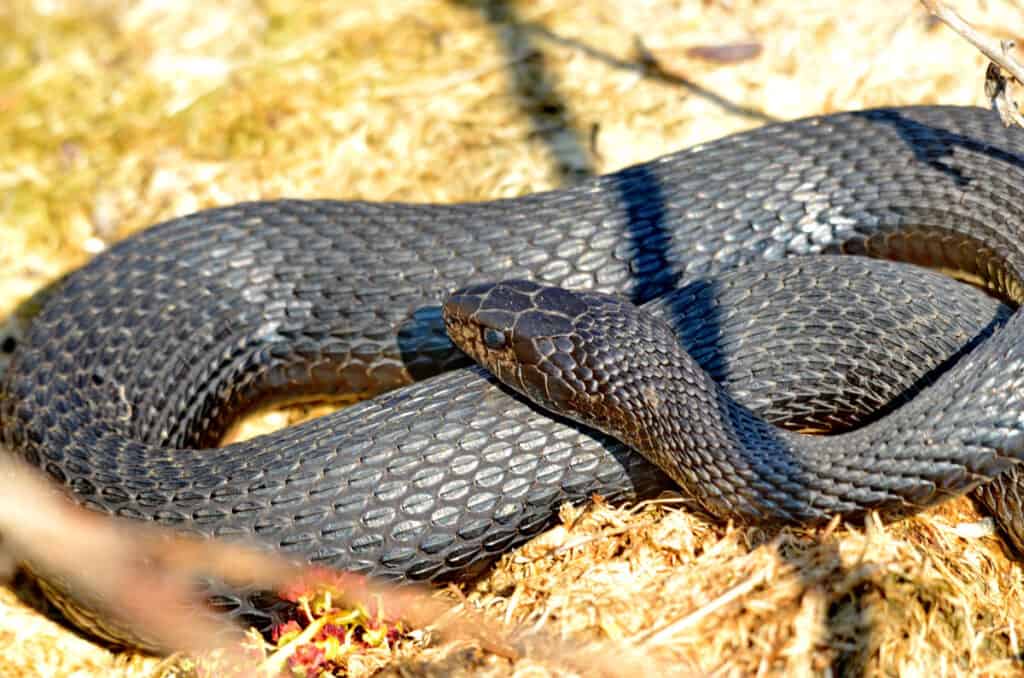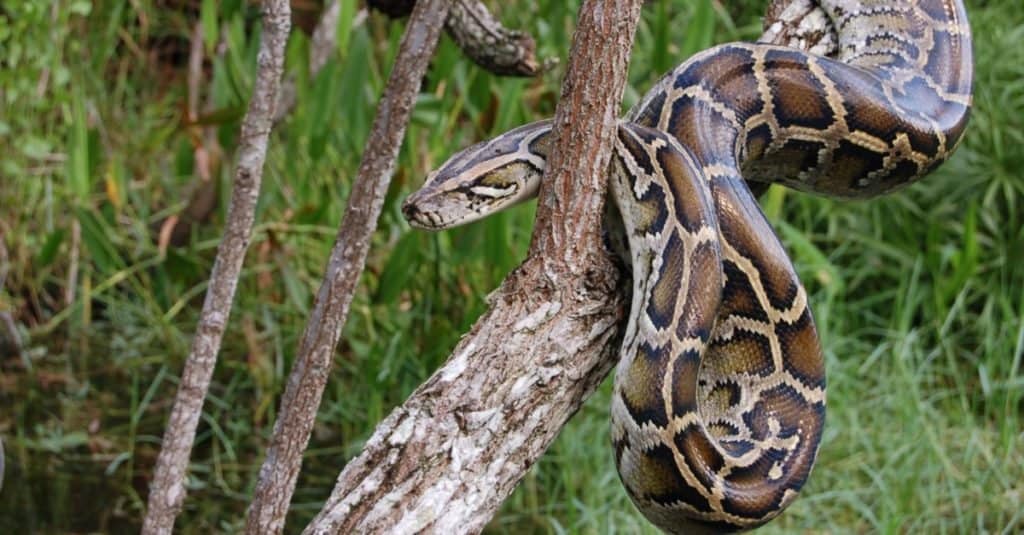Snakes are cold-blooded and rely on the sun’s heat to maintain their body temperatures and support bodily processes like digestion. As we enter fall and winter in the northern hemisphere, reptiles in many regions become sluggish and begin heading toward their dens to hibernate. Those that live in habitats with colder winter temperatures must seek shelter to survive.
Yet, what about Florida? Does it get cold enough for snakes to need to hibernate or, more accurately, brumate?
What is the Difference Between Hibernation and Brumation?

Melanistic garter snakes have an excess of melanin and come in dark shades of brown and black.
©iStock.com/Bob Hilscher
Hibernation typically applies to animals like bears that fatten themselves up during the summer, then sleep through the winter. Animals that hibernate do not need food or water during that period and are usually in a deep sleep state. Hibernation allows them to snooze their way through that portion of the year when resources are scarce. They slow their heart rate, breathing, and metabolism down to conserve energy. In doing so, they can survive for long stretches without food or water.
In contrast, brumation is the reptile or amphibian equivalent. The difference is that reptiles and amphibians that brumate aren’t in a deep sleep state, and most still need to get water at some point during brumation. Some snakes leave their winter home and bask for a little while before returning to rest. Yet, if you happen to uncover a snake’s winter retreat, it can still bite even though it’s very sluggish because of the external temperature.
However, they don’t eat during brumation because without the sun’s warmth to aid their digestive processes, their meals would just sit in their stomach and rot. When they need to brumate, they tuck themselves into cracks and crevices or under rocks or logs to stay safe from predators.
What is Florida’s Climate Like?
Florida’s beautiful year-round weather is legendary. People flock to the sunshine state every year for vacations away from snowy winter weather. Yet, is it really that nice — all year long? As it turns out, Florida weather is more variable than expected.
While the climate is certainly nicer than the cold northeastern states, even Florida’s mild temperatures can swing widely. Aside from the hurricanes that sometimes ravage the state during the rainy season, the winter dry season can bring chilly temperatures to the panhandle and some of the interior areas.
Florida’s climate is the mildest in the continental United States, and average winter lows range from 41°F in Tallahassee to 65°F in Key West. However, it can occasionally get colder than that. According to the USDA Plant Hardiness Zone Map, Florida’s lowest extreme temperature can drop to 10 °F. A chilly temperature for anyone, especially snakes — fortunately, it doesn’t get this cold very often.
Do Snakes Hibernate (Brumate) Alone or With Others?
Like many things with reptiles — it depends. Some species call a sort of truce and share the same hibernation location, known as a hibernaculum, even some species that may otherwise eat one another during the summer.
A few species use the same dens, or hibernacula, for years. For example, rattlesnakes are more social than you’d expect and many use communal dens. Some species even share parenting duties and protect each other’s young. In some extraordinarily large dens, thousands of snakes may share space and body heat through the colder months. Copperheads are also social and share dens with many other snakes and often different species.
Garter snakes are one of the most well-known communal den users. In the Narcisse Wildlife Management Area in Manitoba, Canada, as many as 15,000 red-sided garter snakes congregate in hibernacula across the region. It’s made the area a tourist destination for snake lovers. Scientists estimate that this congregation has existed for thousands of years. Due to the extended cold periods in some areas, some species emerge on sunnier days to warm up and find a drink of water before heading back into the hibernaculum.
In Florida, some snakes, like garter snakes, king snakes, and a few others, may congregate together to brumate. Other species, like most cottonmouth snakes, brumate alone. They’re much less social than other snake species and can be cannibalistic, even eating members of their own species.
Which Snakes Live in Florida?

The most well-known invasive species is the Burmese pythons (Python bivittatus), which have terribly affected native wildlife.
©Heiko Kiera/Shutterstock.com
There are approximately 46 snakes native to Florida, in addition to snakes like the invasive Burmese python. Only six of them are venomous — the Florida cottonmouth (Agkistrodon conanti), harlequin coral snake (Micrurus fulvius), dusky pygmy rattlesnake (Sistrurus miliarius barbouri), eastern diamondback rattlesnake (Crotalus adamanteus), timber rattlesnake (Crotalus horridus), and eastern copperhead (Agkistrodon contortrix) all inhabit Florida. The other native species are nonvenomous and harmless to people.
Here are a few nonvenomous Florida natives:
- The Florida pine snake (Pituophis melanoleucus mugitus) digs its own dens.
- The Rim Rock crowned snake (Tantilla political) lives underground and eats snails and slugs.
- Florida king snakes (Lampropeltis floridana) eat venomous snakes.
- The Rainbow snake (Farancia erytrogramma) is one of the most beautiful Florida native snakes.
There are some non-native species, and some are invasive. The most well-known of the invasive species is the Burmese pythons (Python bivittatus) which have had terrible effects on native wildlife. They’ve established a breeding population, and some reports say there may be over 100,000 giant snakes living and breeding in Florida.
Also becoming established are the African rock python (Python sebae), the boa constrictor (Boa constrictor), and the Javan file snake (Acrochordus javanicus). In their native habitat, these non-natives don’t need to brumate. However, depending on where in Florida they’re located, even these invasive snakes may brumate when the temperatures drop far enough in their habitat.
Where do Florida’s Snakes Go in the Winter?
Unlike the states further north in the United States, many Floridian snakes only need to brumate for short periods of time between November and February or March. Some will do this when even small dips in temperature coincide with shorter daylight hours in preparation for mating season.
In North America, most reptiles aren’t as cold-adapted as the European adder, which is the only snake that lives as far north as the Arctic Circle. While the adder may be found basking in the sun on a snowy day, North American snakes will most likely be tucked into their burrows and hibernacula in temperatures that fall below 60°F.
Here are a few of the snakes that seek shelter when the warm Florida weather gives way to the cold; some, like the eastern diamondback rattlesnake, are known to share dens with many other snakes:
- North American racers (Coluber contrictor)
- Red corn snake (Pantherophis guttatus)
- Scarlet kingsnakes (Lampropeltis elapsoides)
- Eastern indigo snakes (Drymarchon couperi)
- Eastern copperheads (Agkistrodon contortrix)
- Diamond-backed water snakes (Nerodia rhombifer)
- Eastern hognose snakes (Heterodon platirhinos)
- Timber rattlesnakes (Crotalus horridus
- Eastern diamondback rattlesnakes (Crotalus adamanteus)
- South Florida mole kingsnake (Lampropeltis occipitolineata)
Garter snakes, king snakes, and a few others may share hibernacula and keep each other warm.
Just like warm-blooded animals that hibernate, snakes start heading toward their dens when the days grow shorter and cooler. However, Florida’s year-round warm weather means that snakes in the southernmost coastal regions may not need to brumate.
Cold-blooded animals like snakes need the heat the sun provides, so while warm-blooded animals hibernate to avoid struggling to find food, reptiles brumate because they cannot maintain their body temperature without the warmth of the sun.
The photo featured at the top of this post is © digidreamgrafix/Shutterstock.com
Discover the "Monster" Snake 5X Bigger than an Anaconda
Every day A-Z Animals sends out some of the most incredible facts in the world from our free newsletter. Want to discover the 10 most beautiful snakes in the world, a "snake island" where you're never more than 3 feet from danger, or a "monster" snake 5X larger than an anaconda? Then sign up right now and you'll start receiving our daily newsletter absolutely free.
Thank you for reading! Have some feedback for us? Contact the AZ Animals editorial team.






